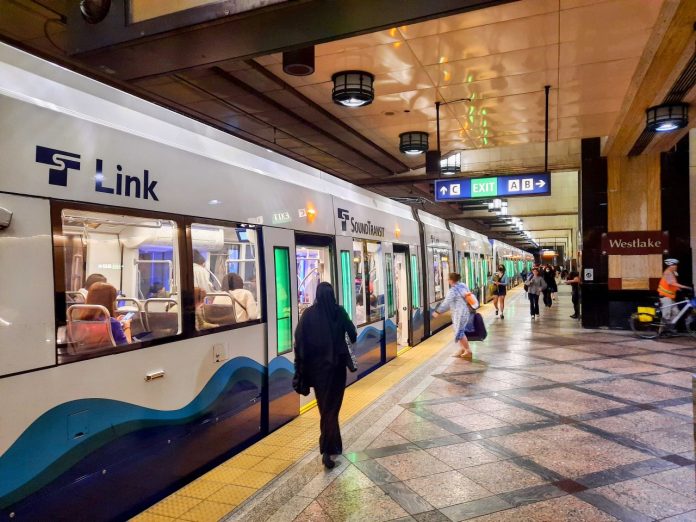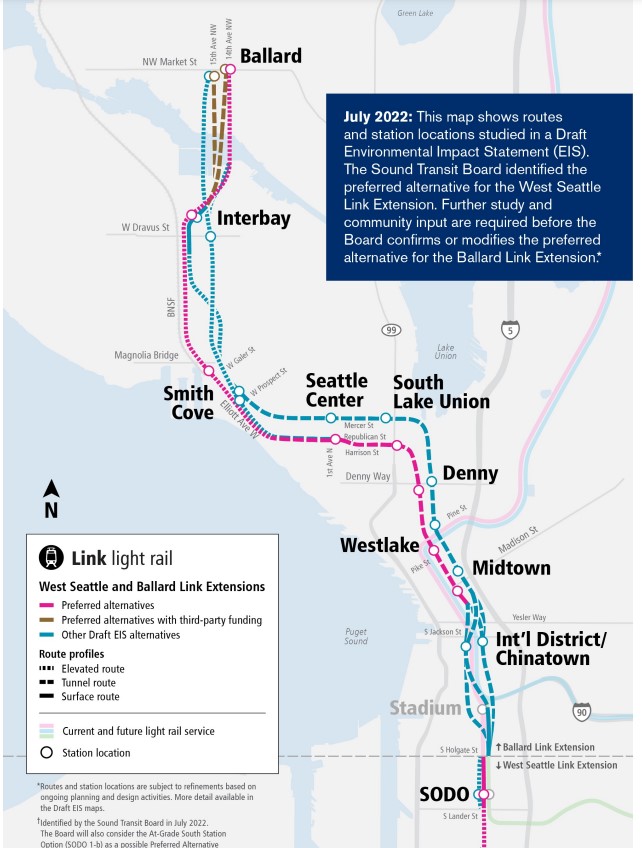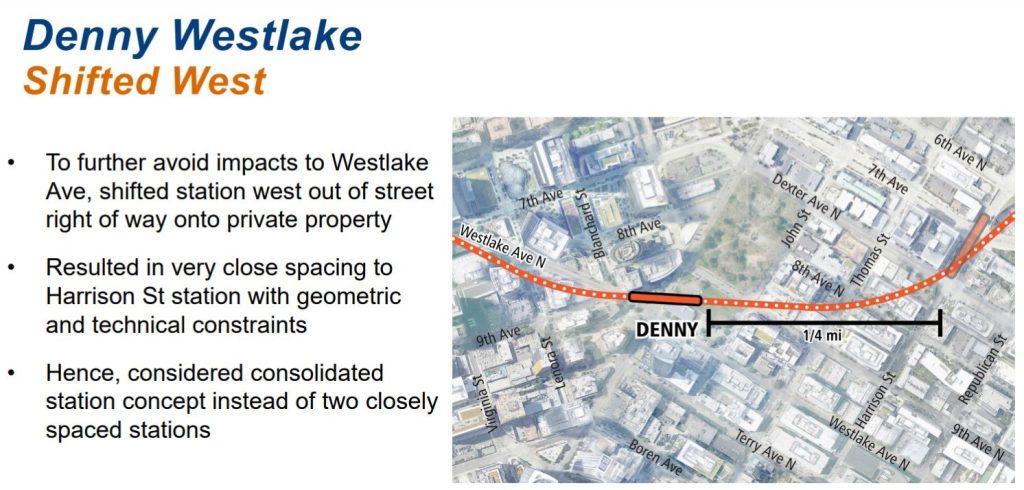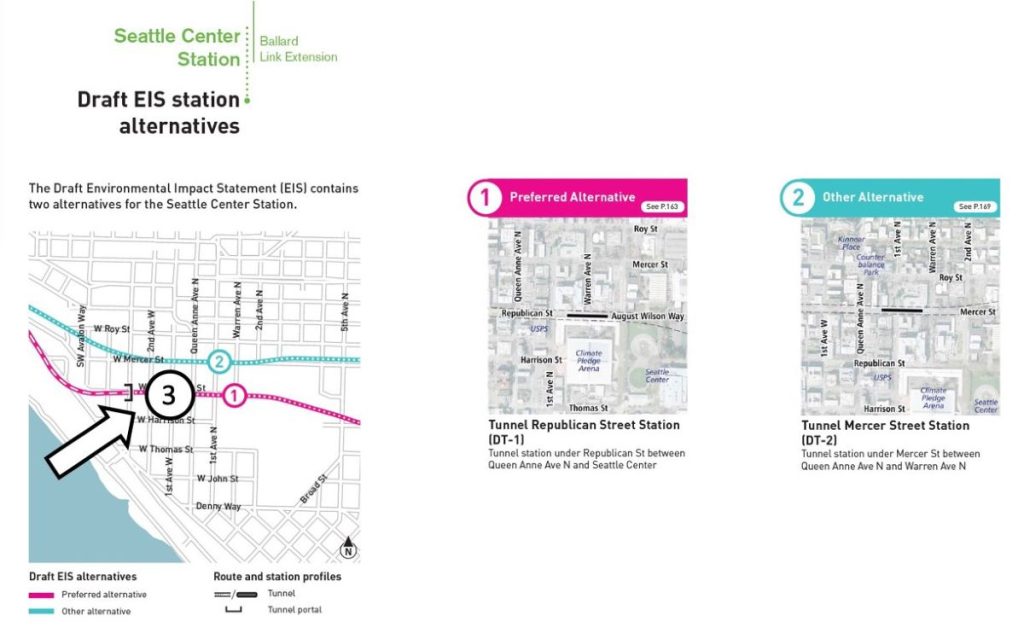
Mayor Bruce Harrell and Amazon have pushed to add a last-minute alternative for Ballard Link light rail that would drop a proposed station in South Lake Union in order to shift Denny Station west off Westlake Avenue. Transit advocates have condemned the idea for worsening transit connections and adding further delays to an already delayed study. The agency had once hoped Ballard Link could open in 2035, but it now says 2039 is the best case scenario as planning has stagnated.
Yesterday, the Transit Riders Union, The Urbanist, 350 Seattle, Feet First, Seattle Subway, and Sierra Club Seattle sent a letter (see below) to the Sound Transit Board of Directors urging that they maintain their selection of the Denny Westlake (DT-1) preferred alternative for the Ballard Link, which would save the neighboring South Lake Union station from the chopping block. They warn that dropping the station planned at Aurora Avenue and Harrison Street would erase a critical connection for tens of thousands of riders on the Aurora bus corridor and jeopardize ridership and lessen the climate benefits of the project. Sound Transit projects South Lake Union Station would attract more than 10,000 daily riders.

Further tinkering with the alternatives also means riders will have to wait longer to see new light rail delivered.
The Sound Transit Board’s monthly meeting is 1:30pm today at the Ruth Fisher Boardroom in Union Station, but it does not appear Ballard Link is on the agenda. Nonetheless, the topic may come up and a decision about the Ballard Link environmental study is looming. The board was already supposed to have selected preferred alternatives in order to advance the agency’s Ballard Link Draft Environmental Impact Statement (Draft EIS) into Final EIS phase, which it must clear before construction can begin.
Instead, Mayor Harrell has proposed a variety of late additions to the plan that will require doing another Draft EIS, delaying the project. Harrell has made these moves from afar. Mayor Harrell did not attend that March board meeting in-person, instead calling in, and he didn’t attend the May meeting at all, sending Seattle Department of Transportation Director Greg Spotts in his stead.

The largest of Harrell’s modifications was to cancel a hub station in the heart of the Chinatown-International District (CID) next door to the existing CID Station and replace it with a station a 10-minute walk to the south. This in turn means abandoning the Midtown Station (on the edge of First Hill) and putting a station a block away from the existing Pioneer Square Station instead in order to replace the lost transfer point in the CID. Only preliminary plans exist so far for the option, but some CID advocates have pushed for the new alternative in the name of avoiding displacement pressure and construction impacts. Other CID advocates have urged Sound Transit to build the promised hub station in their neighborhood and provide better transit connectivity.
After a board vote in March, the new “North and South of CID” option is now considered the preferred alternative, but continuing to keep it in the study will require that the agency complete another Draft EIS, delaying the project by at least a year.
Since then, Mayor Harrell has backed the new last-minute station alternatives in Denny and in Uptown as well. The new Denny Station appeared to be at the behest of Amazon and other corporations and property owners in Denny Triangle who lobbied to avoid construction impacts on Westlake Avenue, which included a full road closure that is projected to last four years while the agency builds the station underneath the road.

The new Uptown alternative that the Mayor wants to study would site the station farther west of the Seattle Center, lessening construction impacts on the arts organizations based in the Seattle Center, but ultimately resulting in a station that is less convenient for people headed to the Seattle Center after the project is completed.
The changes to the plan (which has been in the works for seven years since voters approved Sound Transit 3 in 2016) all fit a pattern of placing temporary construction impacts over the long-term health of the transit network and attracting more riders, which in turn will determine the size of the project’s climate impact. There also appears to be a hope that further study can avoid tradeoffs and obviate the need for tough choices that infuriate a major constituency. While not much is known about new alternatives, that hope appears almost certainly illusory.
Transit advocates should certainly weigh in on the plans lest the city’s transit future is bargained away.
The board accepts public comments at the beginning of its meetings by signing up for virtual comment or attending at Union Station. Written comments can be submitted electronically via meetingcomments@soundtransit.org. The agency notes that “written comments received up to one hour before the meeting will be provided to board members electronically during the meeting, comments received after that deadline will be provided to board members after the meeting.”
Letter from transit advocates:
Dear Board Chair Constantine and Sound Transit Board Members:
We, the undersigned organizations, urge that the Sound Transit Board maintain its selection of the Denny Westlake (DT-1) preferred alternative for Ballard Link construction.
As The Urbanist reported on June 1, the DT-1 alternative scores highest among the four options for maximizing rider performance and minimizing risk. It is also clear that the DT-1 option is most compatible with plans to site a South Lake Union station at Harrison Street.
We cannot overstate the importance of the planned station at Harrison Street. This station would provide, as Mayor Harrell acknowledged on May 25, a “critical” Sound Transit connection for tens of thousands of riders on the Aurora bus corridor. The DT-1 alternative including Harrison Street represents an historic step toward our future as a fully accessible, mass-transit city.
Mayor Harrell suggests further assessment of the Shifted West alternative without abandoning plans for Harrison Street. This Board already knows that the Shifted West alternative is almost certainly incompatible with a Harrison Street station. Shifted West proponents rely on arguments rooted in short-term thinking. Calls for further assessment belie Shifted West proponents’ own pledged commitments to resilient decarbonization and increased access to South Lake Union.
We share Board Member Balducci and Board Vice Chair Keel’s concerns over further delays to construction. Rider performance should be our core priority. The DT-1 alternative is a clear path to a Ballard Link extension that efficiently balances the impacts of construction with the benefits of reducing emissions and economic insecurity through increased ridership.
This Board should stay true to its commitment to safe and efficient transit for every person in Seattle and the Central Sound by continuing to pursue the DT-1 alternative with no further delay.
Sincerely,
Transit Riders Union
The Urbanist
350 Seattle
Feet First
Seattle Subway
Doug Trumm is publisher of The Urbanist. An Urbanist writer since 2015, he dreams of pedestrian streets, bus lanes, and a mass-timber building spree to end our housing crisis. He graduated from the Evans School of Public Policy and Governance at the University of Washington in 2019. He lives in Seattle's Fremont neighborhood and loves to explore the city by foot and by bike.

